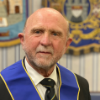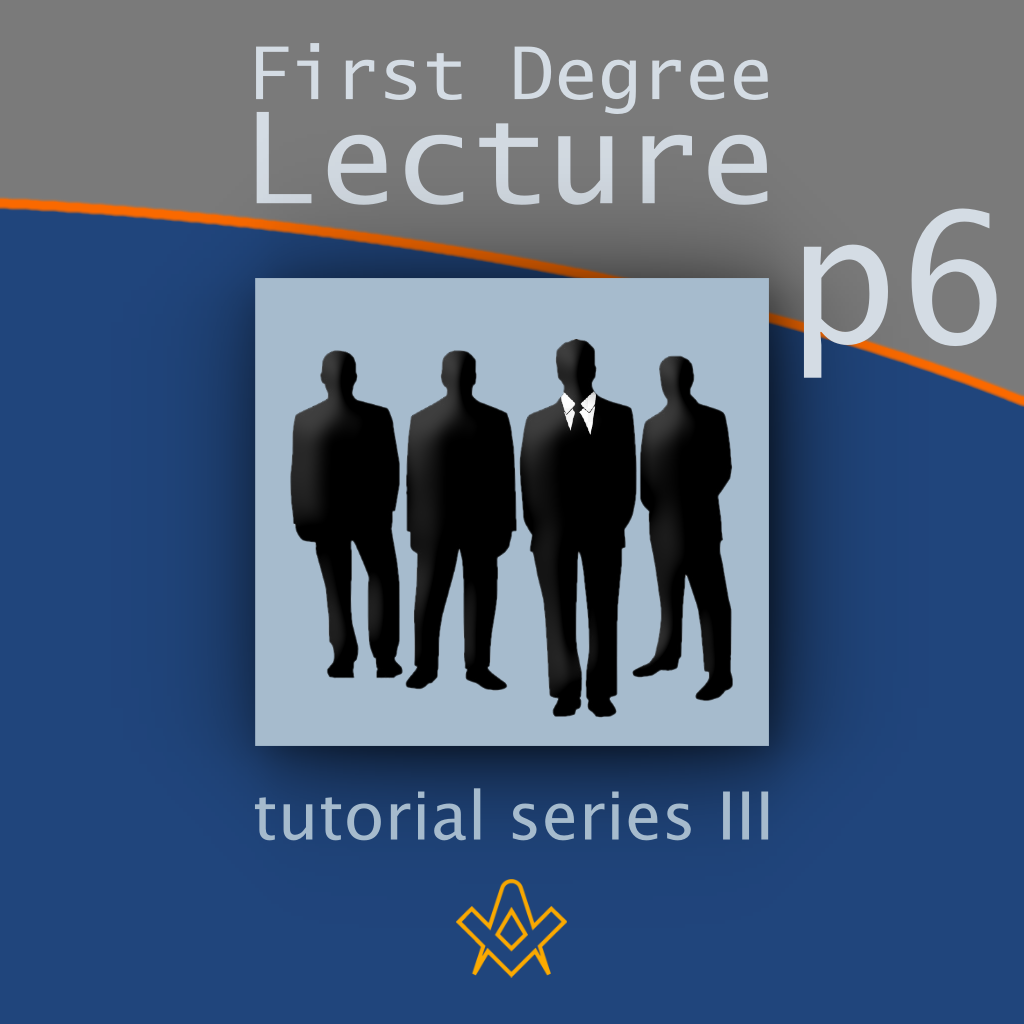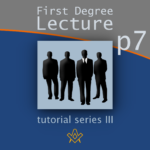Mentor’s Notes – Learning Outcomes
By the end of this tutorial the learner will be able to:
• Explain the first and principle points.
• Explain the Grand Principles
• Explain the four original forms and to what they allude.
The First Degree Lecture, Section Six, by William Preston.
Video Presentation
In Section One, Preston explains the process of testing a stranger who purports to be a Freemason.
In Section Two, he went through the examining of a stranger, who is not a Freemason, enabling him to enter the Lodge on his Initiation.
In Section Three, Preston examines what an Entered Apprentice has to learn, that of being a ‘Moral Man’.
Section Four investigates the form of a Freemason’s Lodge: a parallelepipedon.
In Section Five, Preston takes us inside the Lodge to examine the furniture, ornaments and jewels.
In this section Preston describes the virtues required of a Freemason and the foundations of Freemasonry. Enjoy.
Stephen J. Goulding. PPJGD. SLGCR.
Q – Name the first point in Freemasonry.
A – Left knee bare and bent.
Q – Why is that called the first point?
A – On my bended knees I was taught to adore my Creator, on my left knee bare and bent I was initiated into Masonry.
Q – There is a chief point?
A – To be happy ourselves, and to communicate happiness to others.
(NOTE: Aristotle said, “Happiness is the meaning and purpose of life, the whole aim and end of human existence”.)
Q – A principal point?
A – A point within a circle.
Q – Define that point.
A – In all regular, well-formed, constituted Lodges, there is a point within a circle round which the Brethren cannot err. This circle is bounded between North and South by two grand parallel lines, one representing Moses and the other King Solomon. On the upper part of this circle rests the Volume of the Sacred Law, supporting Jacob’s ladder, the top of which reaches to the heavens; and were we as conversant in that Holy Book, and as adherent to the doctrines therein contained, as those parallels were, it would bring us to Him who would not deceive us, neither will He suffer deception. In going round this circle, we must necessarily touch on both those parallel lines likewise on the Sacred Volume, and whilst a Mason keeps himself thus circumscribed, he cannot err.
(NOTE: The two parallel lines, Moses and King Solomon, represent your mentors keeping you on that straight and undeviating path along which all Masons must travel. Those parallel lines rest on the V.S.L. which is the guide to all your actions.
In some Lodges those parallel lines represent St. John the Evangelist and St. John the Baptist, the two patron saints of Freemasonry.)
Q – Name the grand principles on which the Order is founded.
A – Brotherly Love, Relief, and Truth.
Q – I will thank you to define BROTHERLY LOVE.
A – By the exercise of Brotherly Love, we are taught to regard the whole human species as one family, the high and low, the rich and poor, created by One Almighty Being, and sent into the world for the aid, support, a protection of each other. On this principle Masonry unites men of every country, sect and opinion, and by its dictates conciliate true friendship among those who might otherwise have remained at a perpetual distance.
(NOTE: A sense of ‘equality’ is not a relatively new concept. Freemason’s have been taught and practiced this concept for some 300 plus years.)
Q – RELIEF?
A – To relieve the distressed is a duty incumbent on all men, particularly Masons who are linked together in one indissoluble chain of sincere affection; hence, to soothe the unhappy, sympathise in their misfortunes, compassionate their miseries, and restore peace to their troubled minds, is the grand aim we have in view; on this basis we establish our friendships and form our connections.
(NOTE: Charity is one of the first lessons given in the First Degree ceremony when the Initiate is placed in the North East part of the Lodge.)
Q – TRUTH?
A – Is a Divine attribute and the foundation of every Masonic virtue; to be good men and true is a lesson we are taught at our Initiation; on this grand theme we contemplate, and by its unerring dictates, endeavour to regulate our lives and actions. Hence, hypocrisy and deceit are, or ought to be, unknown to us, sincerity and plain dealing are our distinguishing characteristics, whilst the heart and tongue join in promoting each other’s welfare, and rejoicing in the prosperity of the Craft.
(NOTE: In contemporary culture a phrase of ‘speaking one’s own truth’ has become fashionable. Brethren, there is only one truth which is seen and noted by the Great Architect of the Universe. It is without bias and sees into the heart and the mind.
In order to have an understanding of Freemasonry read ‘Brotherly Love, Relief and Truth several times for this is our Foundation Stone. The more modern version stated by U.G.L.E. is ‘Integrity, Friendship, Respect, Charity’. https://www.ugle.org.uk/ )
Q – How many original forms have we in Freemasonry?
A – Four.
Q – I will thank you to show Masonically to which parts of the body they refer.
A – The throat, refers to the penalty contained in my Obligation, implying that as a man of honour and a Mason I would rather have my throat cut across, my tongue torn from its roots and my body buried in the rough sands of the sea whence the tide doth wash twice in the course of a natural day rather than betray any of the secret or secrets, mystery or mysteries of Masonry.
(NOTE: Quoting an established punishment given by a Court of Law in the 16th and 17th Century.)
Next the breast, where those secrets are deposited safe and secure from the popular world who are not Masons.
The hand placed on the Volume of the Sacred Law, as a token of my assent to the Obligation of a Mason.
The foot formed in a square at the North East part of the Lodge denoting a just and upright Mason.
Q – They have a further allusion.
A – To the four cardinal virtues, namely: Temperance, Fortitude, Prudence, and Justice.
Q – I will thank you to define TEMPERANCE.
A – Is that due restraint of the passion and affections, which renders the body tame and governable, and relieves the mind from the allurements of vice. This virtue ought to be the constant practice of every Mason as he is thereby taught to avoid excess, or the contracting of any vicious or licentious habits, whereby he might, unwarily, be led to betray his trust, and subject himself the penalty contained in his Obligation.
Q – FORTITUDE?
A – Is that noble and steady purport of the soul, which is equally distant from rashness and cowardice; it enables us to undergo any pain, labour, danger, or difficulty, when thought necessary, or deemed prudentially expedient. This virtue, like the former ought to be deeply impressed on the breast of every Mason, as a fence and security against any attempts which might be made either by threats or violence, to extort from him any of those Masonic secrets he has so solemnly engaged himself to HELE, conceal, and never improperly reveal; the illegal revealing of which might prove a torment to his mind, as the Compasses were emblematically to his body when extended to his naked left breast at time of his Initiation.
Q – PRUDENCE?
A – Teaches us to regulate our lives and actions according to the dictates of reason, and is that habit of mind whereby men wisely judge, and prudentially determine, all things relative to their temporal and eternal happiness. This virtue ought to be the distinguishing characteristic of every Free and Accepted Mason, not only for the good regulation of his own life and actions, but as a pious example to the popular world who are not Masons, and ought to be nicely attended to in strange or mixed companies, never to let drop or slip the least Sign, Token, or Word, whereby any of our Masonic secrets might be illegally obtained; ever having in recollection that period of time when he was placed before the Worshipful Master in the East with his left knee made bare and his bent right foot formed in a square while his right hand was placed on the Volume of the Sacred Law
Q – JUSTICE?
A – Is that station or boundary of right, by which we are taught to render to every man his just due, and that without distinction. This virtue is not only consistent with the Divine and human Law, but is the standard and cement of civil society. Without the exercise of this Virtue, universal confusion would ensure, lawless force would overcome the principles of equity, and social intercourse no longer exist; and as justice in a great measure constitutes the really good man, so it ought to be the invariable practice of every Free and Accepted Mason never to deviate from the minutest principles thereof, ever having in mind the time he was placed at the North East part of the Lodge, feet formed in a square being evident, when he received that excellent injunction from the Worshipful Master. To be just and upright in all things; alluding to the Perpendicular.
(NOTE: These four virtues are represented by the tassels on the four corners of the Masonic carpet. When the Lodge is “Squared” Freemasons should pause and reflect upon them.)
Brethren, this ends the sixth section of the first lecture:
May Brotherly Love, Relief, and Truth, in conjunction with Temperance, Fortitude, Prudence, and Justice, distinguish Free and Accepted Masons till time shall be no more.
In Section Six, Preston gives a valuable account of the virtues required of a Freemason. So, when someone is said to be a Freemason, “he is one to whom the burden heart may pour forth his sorry, the distressed may prefer their suit, whose hand is guided by justice and whose heart is expanded by benevolence.” – Ritual – Address to the Master
Article by: Stephen J. Goulding

Stephen was initiated into Freemasonry in 1978 in Tylney Lodge No. 5856 (UGLE). He was Master in 1989 & 2004.
He was Master of the Lodge of Union 38 (UGLE) in 2018. He is also a PZ in the Holy Royal Arch and PM in the Mark Degree.
Stephen served 30 years in the Metropolitan Police Service (London, England) before going into education in 2000, where he became a college lecturer and a mentor for both the college and the University of Greenwich (London, England). Now retired, he teaches Tai Chi and Qigong in the community.
Facebook: Steve Goulding-Tai Chi West Sussex–Chi at Chi
Recent Articles: The First Degree Lecture
masonic knowledge
to be a better citizen of the world
share the square with two brothers

click image to open email app on mobile device













